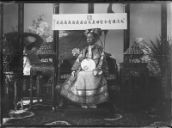Hair diplomacy
Why did the liangbatou and dalachi become so linked to the Manchus? One of the reasons may have been the introduction of photography at the Qing court. Empress Dowager Cixi had grown very self-aware after the disaster of the Boxer Rebellion (1899-1901), and the image of the Empress Dowager abroad was a negative one. In order to change this image, she seemed to have made a conscious decision to go public.
The first major public appearance of the Empress Dowager Cixi was the portrait made by Katherine Carl for the St. Louis’ World Fair in 1904. For the portraits painted by Katherine Carl, Cixi opted to wear the liangbatou and dalachi instead of the traditional Qing crown, the chaoguan 朝冠.[Cf, p 182] For a long time, the looks of the imperial family and Cixi were kept secret, but through this portrait the whole world had the opportunity to see the her.[Cf, p 121] Twenty million people were able to see the Empress Dowager Cixi at the St. Louis’ World Fair where the painting was exhibited, whereas the publication of the painting in Chinese newspapers also allowed many Chinese to see what their ruler looked like.[Cf, p 128] In order to reframe the negative image she had abroad, Cixi also started to hand out photographs of herself as diplomatic gifts.[Cf, p 146-7] In so doing, she broke with the tradition of emperors and empresses to never appear in public.
In these pictures, Cixi wore the dalachi as her headdress. For the numerous parties with the ladies of the foreign legation that Cixi organized, the court ladies and the Empress Dowager herself also wore the dalachi instead of the chaoguan. Arguably, the liangbatou and the dalachi had even obtained diplomatic significance by the end of the Qing dynasty.
It is thus no surprise that the barbie wears a dalachi as a hairstyle. The Manchurian female coiffure became part of the image of China through the invention of the tradition by the Qing court, just like the Manchurian qipao has become a popular Chinese dress.






